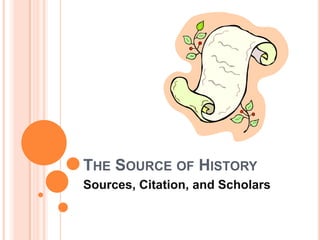
Ss week 2
- 1. The Source of History Sources, Citation, and Scholars
- 2. What is History? Last week we discussed that history is the study of the past. How can we learn about the past? What tells us the story? Fill in the blank. “I can learn about history by looking at a ________. I can learn about history by reading a _______. I can learn about history by listening to a ______.”
- 3. The SOURCE of the Issue We learn about history through pictures, letters, books, poems, movies, cartoons, articles, diaries, etc. These are all known as “sources.” “The SOURCE of the information.” We must ask ourselves 2 questions. How did this source learn about this topic? How reliable is this source?
- 4. Two Types of Sources There are two main types of sources. Primary Sources are contemporary accounts that were eye witnesses to the topic. Secondary Sources are sources that were created from primary sources and by an author that did not witness the topic first hand.
- 5. Compare and Contrast Diaries Letters Journals Speeches Pictures Videos Cartoons Documents Interviews Statistics Journals Articles Books Interviews Documentary Videos Primary Sources Secondary Sources
- 6. How can I tell the difference? Primary Sources are first hand accounts. The author must have been there. These sources are often filled with emotion and reaction. Primary sources are truth but truth with a bias! The author did not witness the topic first hand. Secondary Sources are interpretations of history. Secondary sources are outside examinations of a subject.
- 7. So What? What’s so important about a primary source anyway? Imagine This: You go to the theater with your family to see a great movie. The sights, the sound, the story; it all makes an impact on you. You run and tell your friend about the great show you just saw. You try and explain just how amazing the story, characters, and images are. Imagine This: A friend just came to you and told you about the amazing movie they just saw. Can you feel the excitement of the theater? Can you see the images? No! This is what it is to study history from a secondary source. It’s not as clear or realistic!
- 11. Pictures give us a great visual view of a time period (its clothing, furniture, landscape, etc.)
- 13. John Winthrop’s journal September 22, 1642 The court, with advice of the elders, ordered a general fast. The occasions were, 1. The ill news we had out of England concerning the breach between the king and parliament. 2. The danger of the Indians. 3. The unseasonable weather, the rain having continued so long, viz., near a fortnight together, scarce one fair day, and much corn and hay spoiled, though indeed it proved a blessing to us, for it being with warm easterly winds, it brought the Indian corn to maturity, which otherwise would not have been ripe, and it pleased God, that so soon as the fast was agreed upon, the weather changed, and proved fair after.
- 14. Part 3: Evaluate the document as a source of Information 1. Is this document similar to others from the same time period? 2. How widely was it circulated? 3. What problems, assumptions, and ideas does it share with other documents from the time period? 4. Is there a bias that is hindering the facts from being reported correctly?
- 15. Let’s put it all together! IN CONGRESS, JULY 4, 1776 The unanimous Declaration of the thirteen united States of America. When in the Course of human events it becomes necessary for one people to dissolve the political bands which have connected them with another and to assume among the powers of the earth, the separate and equal station to which the Laws of Nature and of Nature's God entitle them, a decent respect to the opinions of mankind requires that they should declare the causes which impel them to the separation. We hold these truths to be self-evident, that all men are created equal, that they are endowed by their Creator with certain unalienable Rights, that among these are Life, Liberty and the pursuit of Happiness. — That to secure these rights, Governments are instituted among Men, deriving their just powers from the consent of the governed, — That whenever any Form of Government becomes destructive of these ends, it is the Right of the People to alter or to abolish it, and to institute new Government, laying its foundation on such principles and organizing its powers in such form, as to them shall seem most likely to effect their Safety and Happiness…
- 17. let’s Take a Little quiz!1. Define a Primary source.2. why do we look at history from primary sources?3. What is a bias? Why is it important to consider bias?4. Name one question we ask when examining a primary source.